Foundation plants are the first thing people see when they come to your home. So it’s important to choose the ones that looks the best. In this post, I share a list of my favorite perennials and shrubs for landscaping around your house.
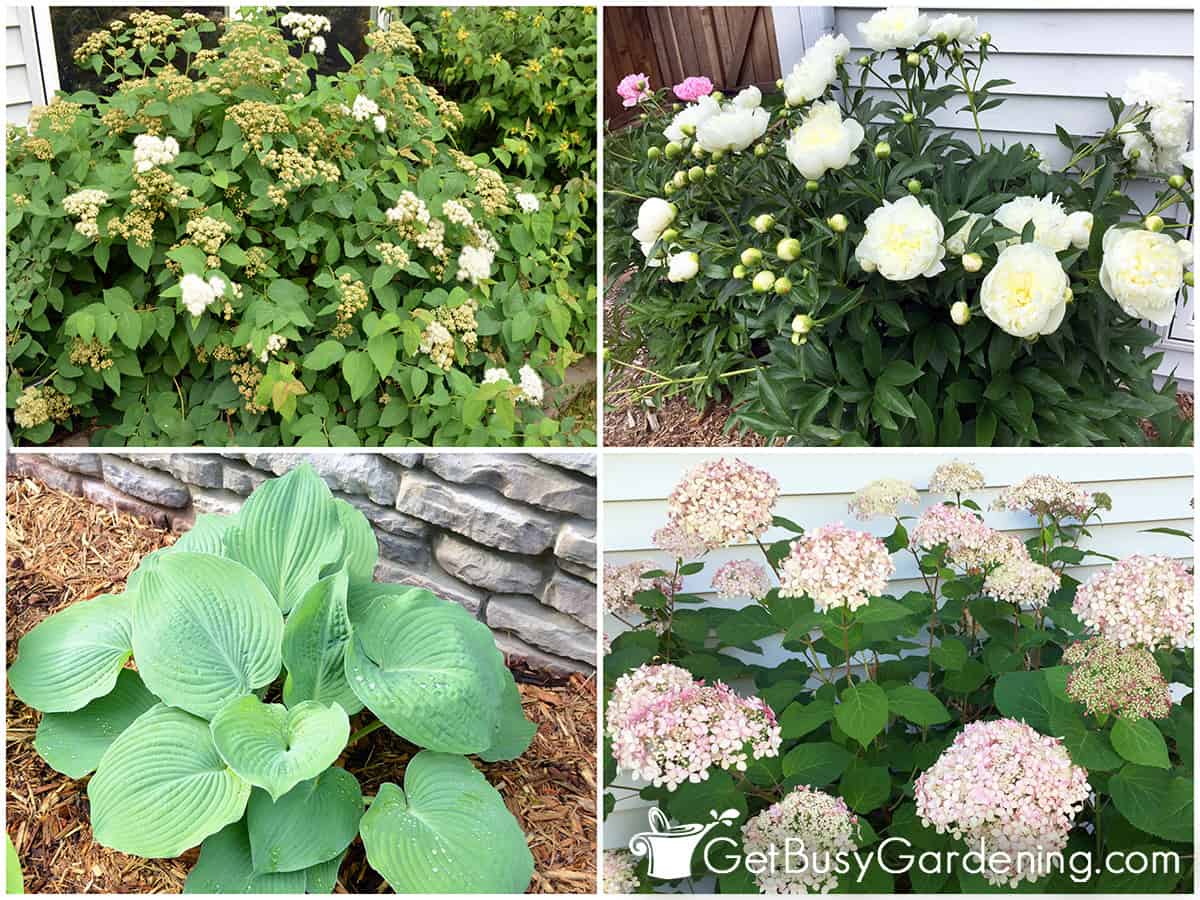
One of the best ways to increase curb appeal in front of your house is to use stunning foundation plants.
From evergreen bushes to flowering perennials, there are many landscaping ideas you can use to add visual interest to your home.
Don’t be overwhelmed by all the choices. This guide will show you the best foundation shrubs and perennials, so you’ll be able to pick out your favorites without any stress.
What Are Foundation Plants?
Foundation plants started as a way to hide the unsightly cement or blocks around the base of newly constructed homes.
Now people add them around their house to enhance the beauty, and break up the monotonous look of a treeless yard, or siding that reaches to the ground.
Landscapers use a mixture of bushes, flowers, and shrubs as a way to create artistic visual interest.
With the right shape, size and color, you can draw someone’s eye around your yard, up the walk, and to the front door. It’s like interior design, but outdoors.
Related Post: How To Design A Front Yard Foundation Planting
When you are looking for foundation plants, these are the attributes that are the most important:
- Choose shorter varieties – If they are too tall, they could block windows, and cause problems for gutters or drainage.
- Add visual interest – Use a range of heights, textures, and colors to create your desired look.
- Keep sunlight needs in mind – If the front of your house receives constant sunlight or full shade, make sure you choose plants that will respond well to it.
- Go for symmetry – Whether you try to use mirror images on both sides of your house, or add visual interest with an asymmetrical design, this list will give you many options.
- Pick ones that look great year-round – Evergreen shrubs or perennials with winter interest will keep your front garden from looking bare during the colder seasons.
Related Post: 17 Best Ground Cover Plants That Grow Well In The Shade
21 Foundation Plants & Shrubs For Front Of House
I split up the list into two sections to make it easier for you to find what you need. First, we will look at the best shrubs for the front of your house.
Then, you will discover the most popular flowers and perennials that you can use to dress up your home landscaping quickly.
Best Shrubs To Plant In Front Of The House
Shrubs and bushes are the most popular foundation plants for the front of the house. They’re easy to care for, make the best base for corners, and anchor your landscaping. Below are some good options.
1. Boxwood
One of the most common foundation shrubs is the boxwood because it’s easy to shape with some hedge trimmers.
These evergreen bushes can reach 6-8’, and do well in partial to full sun. Most people use them as the base or backdrop for their landscaping, and place other colorful specimens around them.
2. Roses
This classic bush comes in a bunch of different shapes and sizes.
You can find them in just about any hue from pink or red, to yellow, orange, and even shades of white, blue, or purple. Simply choose your favorite colors.
Roses also have a variety of heights. Find them in dwarf forms that only reach 1-3’, or larger shrubs and climbers that can get anywhere from 8-20’ tall.
3. Hydrangea
Hydrangeas are another fantastic way to add pops of color to the front of your house.
Their showy flowers bloom in the late summer or early fall. They come in varieties with either pink, green, blue, purple, or even white blossoms.
They do best in zones 4-9, and can reach heights of either 4-6’ or 6-8’, depending on the type you own. Learn how to grow hydrangeas here.
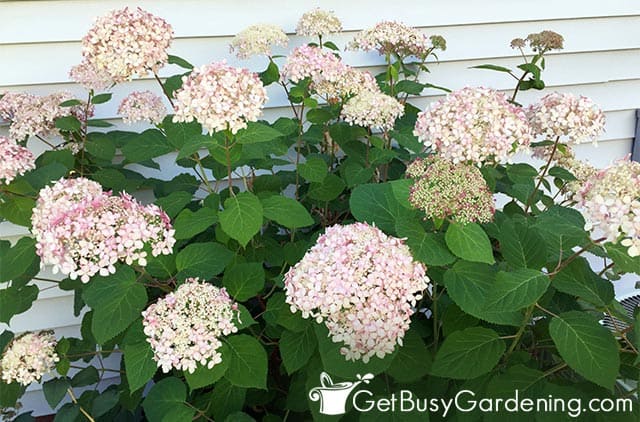
4. Japanese Maple
A much taller option is the Japanese maple, which you can find either as a bush or in a small tree form.
Some of the bush varieties reach 12-15’, and the trees can be 15-20’. So make sure you give them plenty of space, and don’t put them too close to your house.
They are breathtaking in the fall when the leaves change from green to a vibrant red. This deciduous tree or shrub does best in zones 6-9 with full sun.
5. Juniper
This common evergreen shrub is often used by the pros as the bones or an anchor in front yard landscape design.
The juniper is known for its unmistakable berries that grow in between the pines on some species.
It’s a conifer that prefers full sun, and can reach 4-6’. The ones that make the best foundation plants are those that stay closer to the ground, rather than the ones that look like tall trees.
6. Dogwood
In general there are two basic types of dogwoods, a tree and a shrub. While the trees look great, at 15-20’ they can be a bit too large to put right next to your house.
The bushes do best in full sun, and can reach 8-12’. Both are deciduous and thrive in zones 5-8.
Some will even bloom in mid-spring, with lovely pink or white flowers that are highly fragrant and attractive to pollinators.
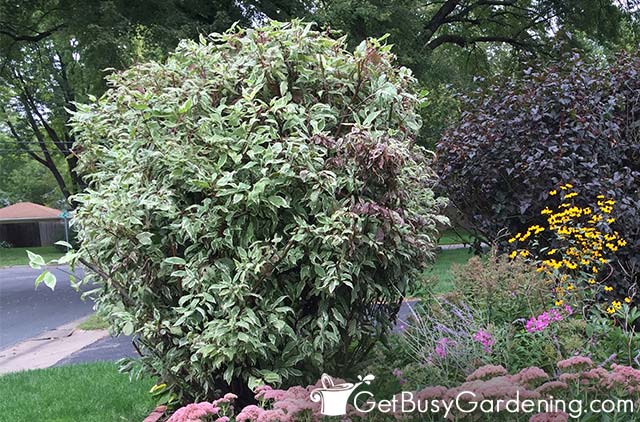
7. Elderberry
The elderberry is a pretty specimen that bears edible fruit. The sweet berries can be used to make jams and deserts, and the birds love feasting on them too.
Though it prefers full sun, it can do well in partial shade as well. This beautiful bush is hardy in zones 3-9, where it can reach 8-10’.
In the late spring and early summer it blooms with white flowers, which are a delightful contrast to the dark maroon foliage.
8. Dwarf Lilac
The dwarf lilac is a fantastic way to line your sidewalks or add color to the front of your house.
Reaching 4-6’ tall, this shrub is easy to trim into stunning round shapes, and small enough to make the perfect foundation plant.
It does best in zones 3-7. In late spring it will come alive with pink or fuchsia blooms that smell heavenly.
9. Weigela
If you’re looking for a bush that has good fall colors to brighten up your yard, try weigela. It does best in sun or partial shade in zones 5-9.
It reaches 36-48” tall, though dwarf varieties can be much smaller. The flowers bloom in late spring and early summer with pink, red, or white petals.
Unfortunately, they aren’t fragrant when they bloom. But the brilliant colors are stunning, and really stand out against the light green foliage.

10. Mock Orange
Don’t let the name fool you. The mock orange has white flowers that look and smell like those on an orange tree, but it doesn’t produce any fruit.
Also known as English dogwood, this large bush towers at 8-10’, and prefers partial shade in zones 4-8.
The highly fragrant blooms appear in late spring and early summer. Place them near a window so you can enjoy the heavenly aroma inside your home when they’re in full bloom.
11. Azalea / Rhododendron
There are lots of types of azalea and rhododendron that you can choose from. All of them are dazzling.
Growing anywhere from 36-48” for the dwarf varieties, or as large as 10-12’ for larger ones, they prefer shade and acidic soil.
They are the epitome of spring in zones 3-8, blooming in late spring with showy flowers and bright colors.
From whites to pinks and shades of purple, to red, orange, and even yellow, they dress up a home’s front landscape.
12. Spirea
With tons of different varieties to choose from, spirea is a popular foundation shrub because it stays fairly small. Most will only reach 24-36” tall.
It’s also a favorite because it’s resistant to deer, and does well in a wide range of zones, from 4 to 9.
The foliage is pretty, and the pink or white blossoms appear in mid-spring.
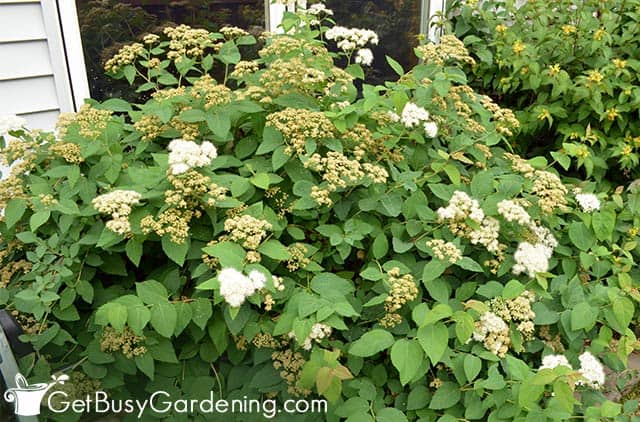
13. Japanese Yew
Another great anchor, the Japanese yew is a low-maintenance coniferous bush that looks captivating in the winter.
The shortest ones, which are 8-10’, make the best foundation shrubs. The taller ones can reach 15-20’, and are better to use farther away from your house.
This is a popular choice for evergreen privacy, and a nice addition to any front garden bed.
Best Foundation Perennials
When it comes to picking out foundation perennial plants, you have a ton to choose from.
The best ones will depend on the color, size, and shape of your home and the existing landscaping. Here are some of my favorites.
14. Lilies
Lilies add artistic beauty to the front of your home, and there are so many varieties that you can pick from.
The sizes range from 1-3’ for the shorter ones, all the way up to an impressive 8’ for the tallest. Though the hardiness varies depending on the species, you can find them for just about any zone.
Most will bloom in late spring or early summer and have stunning, often fragrant, flowers that come in an array of patterns and colors.
15. Hostas
With solid or multicolored leaves that look like they came straight out of a painting, hostas add visual interest to your landscaping.
They only reach 18-28” tall and wide, and do best in shady spots in zones 3-8.
The trumpet-shaped blossoms appear in late summer, and can be anywhere from pale or light purple to white.
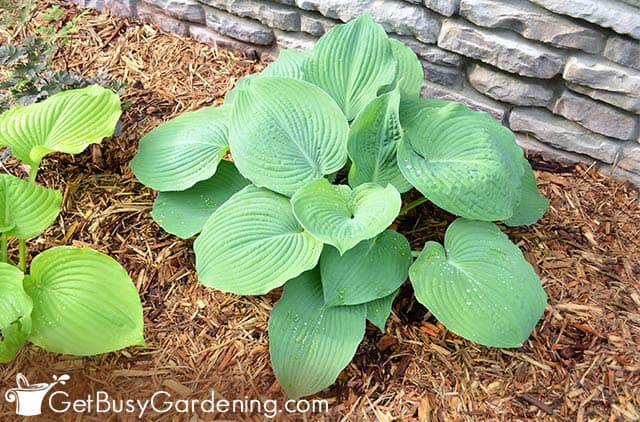
16. Astilbe
Also called false goat’s beard, astilbe has bold red, white, or pink flowers that bloom in mid-spring and early summer.
The colors are electric, and really command attention. They are also fantastic for cutting and adding to your indoor bouquet.
This excellent foundation plant will reach 18-24” and, depending on the variety, can thrive in anywhere from partial shade to full sun in zones 4-9. Learn exactly how to grow astilbe here.
17. Iris
There are hundreds of species of this romantic flower that you can choose from. The most popular is the bearded iris.
Depending on the type you choose, they can reach anywhere from 24-36”. The spiky foliage makes a great backdrop, and the blossoms open in the spring.
They come in a variety of colors, from lavender or blue, to yellow, white, pink, salmon, and dark purple. Some smell wonderful too.
18. Coral Bells (Heuchera)
Also called coral bells, Heucheras add vibrance and texture, and are a classic addition to any landscape.
When the pink or white flowers bloom in early summer, they can reach 18”. But the foliage is the star of the show, and you can find them in just about any color of the rainbow.
They can thrive anywhere from shade to full sun in zones 4-9, and can tolerate drought conditions.

19. Phlox
Very broadly, there are two popular kinds of phlox: tall and creeping. Both require full sun, and are hardy in zones 4-8.
Tall varieties do well in partial shade to full sun, and get to be 36-48”. They have fragrant white, pink, purple, or magenta blooms that appear around the middle of summer.
The creeping ones have a sprawling habit, and barely reach 6” tall. They bloom in early spring, and also come in various colors.
20. Yucca
The yucca is an effortless choice for beginners. These tough evergreen perennials are perfect for drier soils that are typical around a house foundation.
It’s rounded shape with lots of sharp-pointed leaves is easy to spot. Though most commonly used as a desert perennial in zones 9-11, there are cold-hardy varieties that can survive down to zone 3.
When it blooms in late spring, the tall flower spikes stick straight out of the center. They’re usually either pale yellow, pink, or a shade of white, and smell amazing.
The bloom spikes stay short on some types, only reaching 18-36″, while others can get up to 30′ tall. When not in bloom, the foliage is only 18-24”.
21. Peony
There are a bunch of varieties of peonies you can choose from, with a range of different sizes and colors.
The most common one for people to use as foundation perennials is the Chinese peony. It grows 24-36”, and thrives in full exposure.
The showy flowers are well known for their intoxicating fragrance, and bloom in late spring and early summer in zones 2-8. Learn how to care for peonies here.
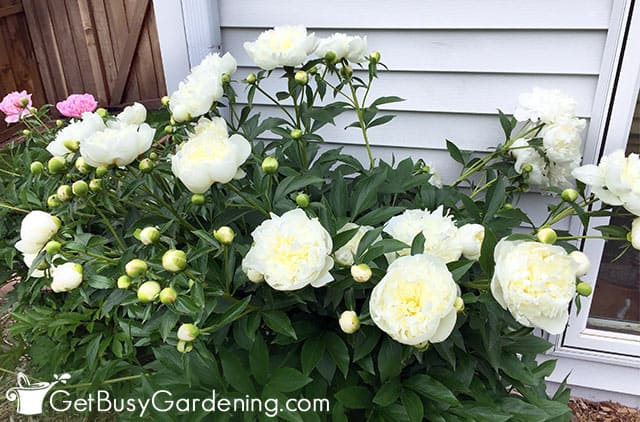
With this list of the best foundation plants for the front of your house, you’re sure to find tons of options. Add some visual interest and beauty to your home with any of these stunning bushes, shrubs, and perennials.
Recommended Books
- Front Yard Gardens: Growing More Than Grass
- New Front Yard Idea Book: Entries, Driveways, Pathways, Gardens
- Create Amazing Combinations with Your Favorite Perennials
- Perennial Combinations That Make Your Garden Look Fantastic
More About Flower Gardening
- 15 Partial Shade Shrubs For Your Garden
- 17 Colorful & Gorgeous Shade Garden Plants
- Create A Bee-Friendly Garden To Help Save The Bees
- 17 Pink Flowers For Your Garden (Annuals & Perennials)
- 19 Long Blooming Perennials For A More Beautiful Flower Garden
Share you favorite types of foundation plants in the comment section below.


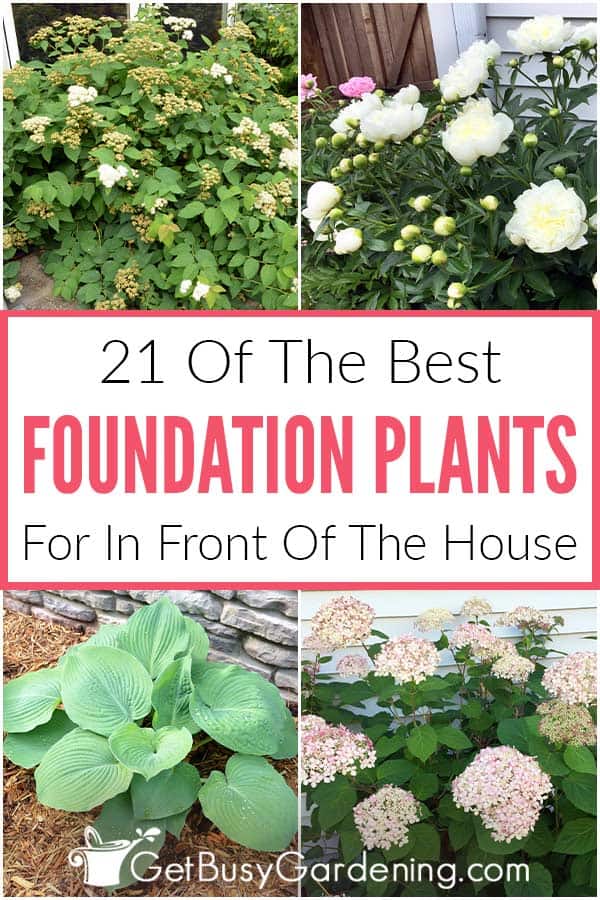


Elizabeth says
I cannot understand why anyone would plant a peony near the house?! A peony is a welcome sign to ants. Ants love a tasty peony and will take the invitation of it being so near the house as an invitation to invade your house. Don’t put a peony near the house, trust me.
Amy Andrychowicz says
Funny, I’ve had peonies next to my foundation pretty much my whole live, and have never had a problem with the ants getting inside the house.
AmyInNH says
Of the above, can concur on spirea and juniper in my sun blasted sandy soil south facing yard. Surprisingly, rose grows in this, eastfacing near the foundation with a arborvitea in front of it for root shade.
Wonder why the incredibly scented clethera/summer sweet’s not in the list.
Amy Andrychowicz says
That sounds like a great addition to the list, thanks.
Deborah Tuders says
What is a good shrub for complete shade
Amy Andrychowicz says
Here’s my list of shade shrubs. Most of those are best for partial shade, but could also do well in full shade.
Heather says
Looks like a great list! I will have to check these out! (Would have loved to see photos of each plant with their description – but that’s just me being lazy so I don’t have to Google each one!) 😉
We are trying to figure out the side of our house that is full sun, 99% of the day. Even getting grass to grow there is hard, as the sun just bounces off the foundation and bakes everything within 3-4ft of the house on that side!
Amy Andrychowicz says
You’re welcome!
Linda says
Not sure what zone you are in, but drift roses love that full sun and only get 2-3 feet high and wide. They are gorgeous and the only maintenance (no pruning) you have to do is spray them during beetle season.
Ann Marie says
What is a great foundation perennial shrub that deters spiders? I would use them on the East and South side of my house.
Thank you!
Amy Andrychowicz says
Spiders don’t like many types of herbs, like basil, mint, lavender, and lemon balm, for example. They also don’t tend to favor chrysanthemums, marigolds, or eucalyptus. Think plants that have a strong fragrance.
Michelle says
Disagree with number 20 wholeheartedly. I inherited Yuccas in my yard from the previous owner and they are a menace! Impossible to get rid of without painstaking work and harsh chemicals. We had to use a small tractor to remove them and then poison the ground where they were. THEN we covered their site with concrete pavers and that was 2 years ago. I’m still hesitant to remove the pavers. They have sharp, stabbing leaves and bloom for like two seconds in June in my zone (6a), then the rest of the time are a hazard to people and animals! Maybe they’re fine for the desert where nothing else grows, but anywhere else more temperate, BEWARE!
Amy Andrychowicz says
Interesting, what zone are you in? I’ve grown yuccas for many years in my gardens, and have never had any problems. They have been wonderful! The leaves are not sharp, so I wonder what variety you have? Are you sure it’s not an agave of some kind?
Michelle says
Hi Amy,
I’m in Zone 6a. I am not sure which variety, but in searching the difference between yucca and agave, I would say the white blooms that we get look like yucca, but at the ends of the leaves are tiny little needle- like projections. I wish I could send you a picture!
Amy Andrychowicz says
Oh, I wonder if yours is a Yucca aloifolia (Spanish dagger) or something else similar. Sorry to hear that you’ve had such a bad experience with yours, I really love mine.